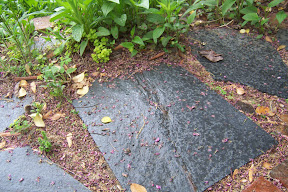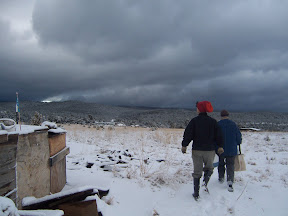Connecting to the weather
By Peggy Ashbrook
Posted on 2009-04-28
 Can you tell that it will rain soon by the way the air smells? Do you like the smell of snow? I like the way the air smells just as a badly needed rain begins—it makes me think of the earth exhaling as the water soaks in (but this could be a misconception on my part).
Can you tell that it will rain soon by the way the air smells? Do you like the smell of snow? I like the way the air smells just as a badly needed rain begins—it makes me think of the earth exhaling as the water soaks in (but this could be a misconception on my part).
(Click here to see the details of the raindrops and the fallen redbud tree flowers.)
Rainfall is a significant event in children’s lives, in some places a daily one, while in others a rare pleasure. Rainy days usually mean that children play indoors so they may not know how much it rained or how long. What can we do to connect children to the patterns in nature determined by precipitation?
Taking brief note of the weather as part of a daily circle or calendar is more common in early childhood classrooms than recording those weather observations through drawings, photography, or writing. When temperature, precipitation, and cloud cover are recorded on a year-long chart, seasonal changes can be easily seen.
 Notable events, such as, “the storm that blew down the big tree” or snow days that closed school, can be highlighted and reflected upon. If you record weather phenomena, compare your class’ results with that of the National Weather Service, Climate Prediction Center.
Notable events, such as, “the storm that blew down the big tree” or snow days that closed school, can be highlighted and reflected upon. If you record weather phenomena, compare your class’ results with that of the National Weather Service, Climate Prediction Center.
Recording the weather can help children make sense of the natural phenomena that are not in our control but affect our lives profoundly. I knew a three-year-old who cried when she noticed any clouds moving overhead. I wonder if drawing the clouds daily in a notebook might have reassured her that they were a familiar occurrence, and not threatening. Teachers who live in areas with occasional severe weather—how do you talk about it with young children? Please add your comments by clicking on the word “Comment” below.
Peggy
Disclaimer: The views expressed in this blog post are those of the author(s) and do not necessarily reflect the official position of the National Science Teaching Association (NSTA).


